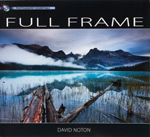David Noton recalls a trip to the City of Love where he used infrared to capture Paris in a unique light
 One of the foremost travel and landscape photographers working today, David Noton tirelessly travels the world in search of new challenges, which he shares with you here
One of the foremost travel and landscape photographers working today, David Noton tirelessly travels the world in search of new challenges, which he shares with you here
In April 2010, I took a trip to Paris to revisit some infrared work I did in France back in the 1990s. I really like using infrared because it gives you an alternative view of the world, and it?s this function of infrared that I thought would help me show this oft-photographed city in a new light. Everyone has seen pictures of the Eiffel Tower. It?s one of the most photographed landmarks in the world, but I wanted to bring a different approach to this well-known icon.
For this project I had my Canon EOS-1Ds Mark II converted by a specialist company. The problem with shooting infrared images on a normal camera is that you need a very dark filter over the lens and it?s more difficult to compose because you can?t see what you?re doing. A converted camera has the filter over the sensor. Either way, you get an indication of how the shot will look on the camera?s LCD screen, but it will appear as a red picture and you have to mentally convert it to black & white.
To make a good composition when shooting infrared you need to think in terms of texture, shape and form, and pretty much disregard any thoughts on colour. I like to work with extreme wideangle lenses because it helps you frame a lot of sky in the picture, which always works really well on bright days. For this image, I shot with a 17mm tilt-and-shift lens with the maximum amount of shift so that I?m looking up at the picture but it?s not falling over backwards.
It?s worth noting, too, that when using wideangle lenses to frame more of the sky, you need to make sure you have some clouds to add shape and texture to that space, otherwise you will have empty black at the top of your frame. Days with sparse clouds are perfect for these compositions.

Next, you want to look for something to stand out against the sky ? you want to have a clear juxtaposition of, for instance, the white of the trees against the strong black of the sky. In this image, the Eiffel Tower is a strong shape that is a contrast of the two. What I like about this picture is that I have all these elements to create something a little bit different, yet the image still says Paris even by just showing that part of tower.
Paris is the place that really pulls me infrared-wise. First, it?s very close to Britain and easy to get to. Composition-wise, it has so much nice foliage that I find that showing the contrast of new spring leaves against the shapes of the city?s numerous old buildings makes for really interesting pictures. Buildings are inherently interesting, but without that foliage it?s not going to be as dramatic as it could be.
The other interesting thing about shooting infrared is that to get good pictures you need to start work earlier than you would with conventional photography, such as around noon or early afternoon. This is because you want the high sun to shine on the foliage. Fresh vegetation records really bright on infrared, which is why you get the stunning luminescent effects, so you need harder sunlight for an infrared image to be effective. When you look at an infrared picture straight out of the camera, it looks soft and lacks contrast early in the morning and late afternoon ? the traditional ?golden hours?.
You need to remember that with infrared you are photographing with light you can?t see. A lot of it is intuitive and you have to predict how light will react to different elements within your frame. Experience is really the only way to tell what will work and what doesn?t. Sure-fire bets for subjects that work are fresh foliage and dramatic blue skies with bold clouds, but the beauty of working with infrared is that you?ll discover so many more subjects that work well in the hard sunlight that you never would have considered before.
I?ve been doing some landscape work around where I live using my infrared camera simply because of the foliage. Infrared is fun because it?s a new way of thinking and helps you see subjects and potential pictures in new places ? and that is what photography is all about.
 David Noton?s new book Full Frame is now available price £25. It follows David?s journey to ten different locations around the world and gives invaluable insight into his approach and working methods. For more details, visit www.davidnoton.com
David Noton?s new book Full Frame is now available price £25. It follows David?s journey to ten different locations around the world and gives invaluable insight into his approach and working methods. For more details, visit www.davidnoton.com






